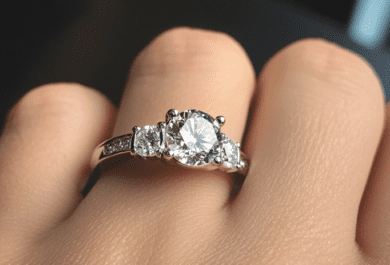The problem started back in 1812 when Friedrich Mos developed the Mohs scale for gemstone hardness. He took a selection of stones and used them to scratch each other. Harder stones would scratch softer ones and he organized them into a ranking from 1 – 10 with diamond being the hardest. Nothing will scratch a diamond except another diamond. This is correct and diamond is in fact quite a bit harder than 2nd place (sapphire) and it has lead to a long standing belief that diamonds are indestructible.
Resistance to breaking and resistance to scratching are two different things. Wood, for example, is generally very soft and easy to scratch but pretty strong when it comes to breakage. Pine is easy to scratch with your fingernail but buildings made from it can last a lifetime and beyond. Glass is at the other extreme. Under normal circumstances it doesn’t scratch all that easily but it can be terribly fragile. Diamonds fall in between. Although they are nearly impossible to scratch under normal wear, they can chip with just the right impact.
Paragraphs like the above tend to lead to a fair amount of stress for diamond customers who read them, especially for those who are currently in the process of shopping for a pricey diamond. What are the risks? As an appraiser I see chipped diamonds fairly regularly (as do most appraisers) and this can lead to us having a fair amount more experience at this than most people, but it can also make us somewhat jaded about it. We see way more than our share. Chipped diamonds come in through estates where it’s been worn for a lifetime and now have a new owner, they come in from consumers who have damaged a stone while wearing it or with a new purchase that was damaged by the jeweler in setting. They come in from jewelers and insurance companies who have a damaged stone either on behalf of one of their clients or that they own and want to know what they can expect for results for repairs. In almost every case it comes as a surprise to the client that it’s possible to break a diamond.
The good news is that, overall, the risk of breaking a diamond on any particular day is pretty low. How low will depend on your lifestyle but it’s instructive to watch the insurance companies who are in the business of assessing risks like this. Almost all companies that offer jewelry insurance offer an ‘all risk’ policy that includes coverage for breakage as well as things like theft, fire as well as the more usual perils that people expect from such a policy. They don’t publish how the odds of the various risks break down in terms of claims but theft, not breakage is surely at the top of the list. In exchange for assuming all of these risks, they charge a premium of 1-3% per year and they’re turning a pretty good profit at this deal. If we guess that half of the claims are for breakage you can calculate that they figure that their ‘average’ customer breaks their stone something on the order of once very 200 years. It’s also worth noting that the companies don’t charge a different premium depending on what you have. It’s the same for princess cuts and rounds, for tension sets and bezels and for engagement rings that are worn daily or specialty things that come out of the box once a year. They know that certain items are more prone to breakage than others but they’ve decided it’s not worth the time and aggravation to charge different premiums based on this.
Someone is going to be that 1 out of 200 owner and it just might be you.
Now what? First, as mentioned above, most insurance policies will cover this and a good first step it to call up your insurer and discuss with them your coverage as well as their claims procedures. It’s often surprisingly painless. Most will have a jeweler or a list of several in your area that they’ve contracted with in advance to assist with this sort of claim. They can offer you alternatives ranging from a full replacement or a cash settlement to a repair with a partial cash payment for the loss in value. The details of this are the subject of a different article and these details vary from company to company and policy to policy but the claims adjuster or your agent should be able to explain the procedure for your particular company and policy. If you’ve got a policy in force when you discover that your diamond is chipped, call the company and inquire about filing a claim. This is part of what you’re paying them for.
Second, in some cases, jewelers will offer warranty coverage that includes a guarantee against chipping. It’s not that their stones break less, they are just including this insurance component as part of their sales of their sales presentation. As with the insurers, this will depend on the policy of the particular jeweler and the ones who have generous programs usually mention this proudly in their advertising as well as in the paperwork they give you at the time of sale. If you buy a stone with one of these ‘warranties’, make sure to read the fine print. There are often restrictions about how often you must return to the store for an inspection and it will often void your warranty if anyone else works on the piece, even to size or simply polish it. With most of these, the store will simply replace the damaged diamond with another of comparable specs from their inventory. If you suspect that your jeweler might have a warranty program in force, dig out your paperwork then call them up to discuss your options.
But what if you’re not insured, and you’re not covered under a warranty? First, take it to a qualified grader to inspect the piece and assess the situation: you may be at risk for further damage if you do nothing or it may be something that you can simply live with. The difference can be pretty subtle and an experienced eye is very helpful. Most chips are along the outside edges of the stone and on the points of princess cuts, pears and the like. A fair number of them can be repaired for a relatively reasonable fee and with only a nominal loss in value. This is a specialty area of jewelery: not all jewelers are experienced at it but talk to them or your appraiser about how to go about getting it repaired as well as what to expect in the way of results. Don’t forget the repairs to the mounting and the re-appraisal of the finished piece. These are both important parts of the repair. The jeweler may also be able to modify the piece to conceal the damage in other parts of the design. Sometimes this is as simple as rotating the stone in the setting or it may involve adding a new design element. Don’t skip the appraisal when you’re done. Failure to do so can cause the insurance company to decline future claims because you have withheld ‘material facts’ from them and the newly repaired stone is a new item for purposes of insurance. If you didn’t have insurance before, you might consider starting a policy now.
Since we’ve discussed getting appraisals a bit, let’s explore the value and process of them. There’s far more to a good appraisal than just a value conclusion. The appraisal you submit to the insurance company or that you keep in your own files after you buy a new item is the benchmark of exactly what you have at that point in time. This serves as evidence of an independent witness who has attested to the condition as of a particular day, presumably shortly after your received it. This protects not only you, but the jeweler and the insurer as well. It protects you in that any claim of damage to an insurer must come with the claim that the damage is new since they agreed to the policy. If it was broken when you got it, it’s reasonable that the insurance company should disallow the claim and you should be talking to the jeweler about it. By specifically documenting the condition you are eliminating this loophole. It protects the jeweler in the same way. They don’t want you coming back and accusing them of selling a damaged or defective diamond months or even years in the future. By getting it appraised by an independent appraiser immediately they have the opportunity to address any concerns at once. It protects the insurer by defining exactly what they must do for a replacement. Detailed and specific appraisals lead to claims that can be processed quickly and to a client’s 100% satisfaction. Happy clients after claims mean continuing and repeat business for them.
Most people are naturally concerned with what they can do to minimize their risks, even when they’re insured or under warranty. To some extent, it helps to be just plain lucky but chips generally happen when the edge of the stone is knocked against something hard. Granite countertops, porcelain sinks and other jewelry items with diamonds in them are the most common culprits. When you’re wearing your jewelry be careful about these surfaces and, when you’re not wearing a piece, put it in a soft bag or compartment in your jewelry box to prevent knocking things against one another. Be careful about putting it in your pocket or purse where it can knock against other things. Have it checked periodically by a professional. Most jewelers are happy to offer a free service to clean and check your pieces whether or not you bought the item from them. This can be a good source of repair business for them and while you’re in the store they have the opportunity to sell you something else. It can also serve as a low pressure way for you to get a feel for a store that communicates well with you and that may deserve your business if and when you do decide to buy something else. A bit of common sense into how and where you wear your jewelery can reduce both your chances of breakage and your chances of loss.
A particular area of concern is damage that may be caused by the initial jeweler while setting the piece or when the stone is moved from one piece to another. This can be especially important for customers who buy a new diamond from one source and have it set by another. Before you have a diamond set or have a piece modified, ask the jeweler specifically for their policy regarding breakage and have the diamond inspected for any preexisting damage. Policies on this vary quite a lot from one to the next. In general, the cheapest craftsmen will not be the ones with the best coverage and may people find this to be an important criteria in choosing a setter. As with the above, the risk here is relatively low in most cases but it may be worth considering an insurance policy that covers this if your jeweler says they won’t. Ask your insurance agent about your choices for coverage and, if they don’t offer it, ask jeweler or appraiser for a referral to a company that will.
by Neil Beaty
Professional Appraisals in Denver
http://www.americangemregistry.com/

Discuss on forum What do you mean diamonds can chip?!











